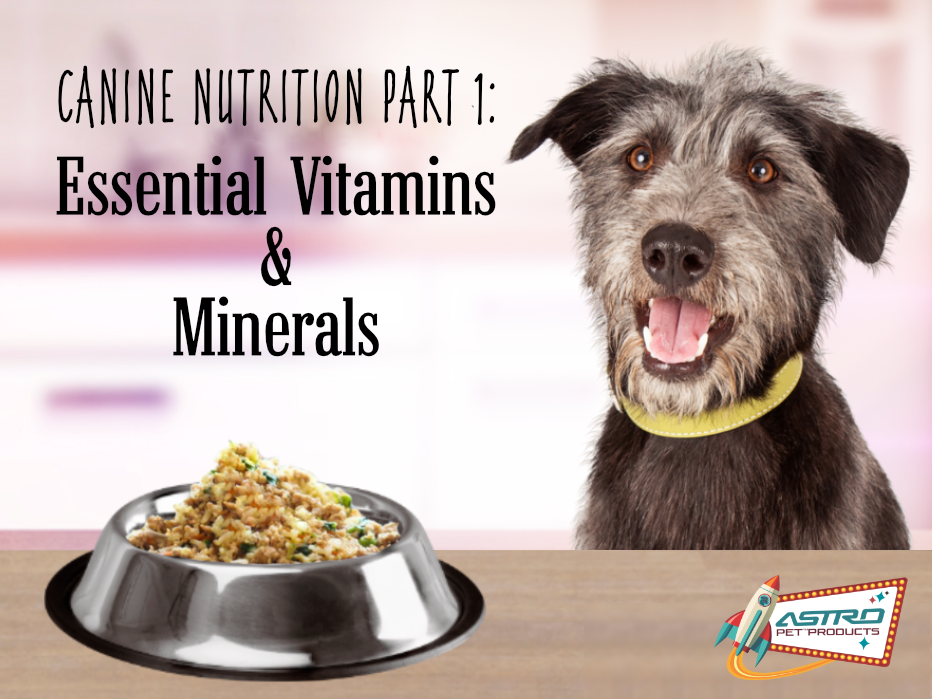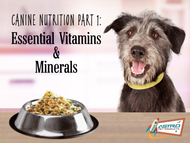Canine Nutrition Part 1: The Essential Vitamins and Minerals
Posted by Michelle Matlock on Jul 31st 2025

Ensuring that dogs receive vitamins and minerals in their diet is crucial for their health and wellbeing. Just like humans’ dogs require a balanced diet to support bodily functions, growth, repair and the immune system.
You can feed your dog commercial, prescription or homemade food. Commercial diets should have all the necessary vitamins and minerals included in the food. Prescription diets may have less than required vitamins and minerals due to specific illnesses or diseases, this is why they are prescription diets. Homemade diets require either vitamin and mineral supplements or diet needs to be balanced by a nutritionist. Homemade diets can be either cooked or raw fed but raw fed diet is not typically suggested for diabetic dogs since their immune system is compromised.
Today I am going to go over the essential vitamins and minerals that a dog requires in their diet along with deficiencies, excess and sources of said vitamins and minerals. This will be a multi-part blog on Canine Nutrition.
Grab a cup of your favorite caffeinated beverage and let’s jump right in!
Before getting into the essential vitamins and minerals we should go over some basic terms that will be used throughout this blog series.
Nutrients
Nutrients are required for the body to grow and function properly, this includes metabolism, cellular repair, growth and maintenance. There are seven nutrients:
- Water - required for life and plays a crucial role in the proper functions of the body.
- Energy - also known as calories - is what feeds the body. Energy comes from protein, fats and carbohydrates.
- Protein - breaks down into amino acids.
- Fat - breaks down into fatty acids.
- Carbohydrates – simple and complex: break down into glucose. Glucose is the main source of energy used.
- Vitamins – fat soluble and water soluble; there are essential and non-essential vitamins.
- Minerals – minerals, trace minerals and electrolytes are required for growth, reproduction, repair and maintenance.
Macronutrients
Macronutrients provide energy and are:
- Protein
- Fat
- Carbohydrates
Micronutrients
Micronutrients are vitamins and minerals the body needs in very small amounts. There are water-soluble and fat-soluble vitamins. Minerals include macro minerals, trace minerals and electrolytes.
Essential vitamins
There are eleven essential vitamins that a dog requires. There are fat-soluble vitamins and water-soluble vitamins.
The following are fat-soluble vitamins, below are their functions, deficiency, excess and sources of each vitamin.
|
|
FAT SOLUBLE VITAMINS |
|
|
A |
• |
Function: vision, skeletal growth, maintenance of skin & coat. |
|
|
• |
Deficiency: impaired growth, reproductive failure, loss of epithelial integrity, dermatosis. |
|
|
• |
Excess: skeletal abnormalities, sensitivity to stimuli. |
|
|
• |
Sources: fish liver oils, milk, liver, egg yolk. |
|
D |
• |
Function: regulates calcium absorption & metabolism, promotes normal bone calcification. |
|
|
• |
Deficiency: rickets, osteomalacia, nutritional secondary hyperthyroidism. |
|
|
• |
Excess: hypercalcemia, bone resorption, soft tissue calcification. |
|
|
• |
Sources: liver, some fish, egg yolk, sunlight. |
|
E |
• |
Function: biological antioxidant that protects cells & tissues from oxidative damage. |
|
|
• |
Deficiency: reproductive failure |
|
|
• |
Excess: nontoxic, may increase vitamins A & D requirements. |
|
|
• |
Sources: vegetable oils, leafy greens, fish. |
|
K |
• |
Function: normal blood clotting, wound healing, bone health |
|
|
• |
Deficiency: increased clotting time, hemorrhage. |
|
|
• |
Excess: none recorded. |
|
|
• |
Sources: liver, leafy greens, broccoli, some fish meals. |
Now for the water-soluble vitamins:
|
|
|
WATER-SOLUBLE VITAMINS |
|
B1 (thiamine) |
• • |
Function: required for nervous system function & energy utilization. Deficiency: central nervous system dysfunction, anorexia, weight loss. |
|
|
• |
Excess: nontoxic |
|
|
• |
Sources: whole grains, eggs, beef, pork, salmon, liver, legumes. |
|
B2 (riboflavin) |
• • |
Function: required for oxidative reactions & cellular use of nutrients. Deficiency: central nervous dysfunction, dermatitis. |
|
|
• |
Excess: nontoxic. |
|
|
• |
Sources: organ meat, meat, salmon, sardines, cruciferous vegetables. |
|
B3 (niacin) |
• |
Function: required for normal nutrient metabolism & energy utilization. |
|
|
• |
Deficiency: black tongue disease (chronic deficiency), indigestion, bad breath, weight loss, fatigue, swollen mouth, tongue |
|
|
• |
Excess: nontoxic. |
|
|
• |
Sources: meat, organ meat, fish, poultry, legumes, grains. |
|
B5 (pantothenic acid) |
• • |
Function: required for nutrient (carbs, fat, amino acids) metabolism. Deficiency: anorexia, weight loss, hormone imbalance, weakened immune system. |
|
|
• |
Excess: none recorded. |
|
|
• |
Sources: liver, kidneys, dairy products, legumes. |
|
B6 (pyridoxine) |
• • |
Function: involved with protein and amino acids metabolism. Deficiency: anemia, skin irritation, impaired immune function. |
|
|
• |
Excess: none recorded. |
|
|
• |
Sources: organ meats, fish, starchy vegetables |
|
B7 (biotin) |
• • |
Function: metabolism of fats and amino acids, healthy skin & coat. Deficiency: dermatitis, hair loss, brittle nails, lethargy. |
|
|
• |
Excess: non-toxic. |
|
|
• |
Sources: eggs, liver, salmon, sardines, oysters, meat, legumes. |
|
B12 (cobalamin) |
• • |
Function: essential for red blood cell formation Deficiency: anemia, gastrointestinal issues, lethargy, neurological symptoms, poor growth in puppies. |
|
|
• |
Excess: non-toxic. |
|
|
• |
Sources: lean meats, poultry, eggs, sardines, liver, kidneys, legumes. |
Now let’s look at essential minerals, this includes minerals, trace minerals and electrolytes.
|
|
ESSENTIAL MINERALS |
|
|
Calcium |
• |
Function: necessary for skeletal growth and maintenance, blood clotting, nerve and muscle function. |
|
|
• |
Deficiency: rickets, osteomalacia, nutritional secondary hyperthyroidism |
|
|
• |
Excess: impaired skeletal development, contributes to other mineral deficiencies. |
|
|
• |
Sources: dairy, poultry, meat meals, bone |
|
Phosphorus |
• |
Function: necessary for skeletal growth, muscle formation, nutrient metabolism, energy production, reproduction. |
|
|
• |
Deficiency: pica, decreased growth, dull coat rickets, spontaneous bone fractures, infertility. |
|
|
• |
Excess: bone loss, calcification of soft tissues, secondary hyperthyroidism, decreased weight gain. |
|
|
• |
Sources: meat, poultry, fish, seafood, legumes, whole grains |
|
Magnesium |
• |
Function: component of the skeleton, necessary for muscle contraction and nerve impulse transmission. |
|
|
• |
Deficiency: soft tissue calcification, enlargement of long bone metaphysis, neuromuscular irritability. |
|
|
• |
Excess: unlikely, absorption is regulated according to needs. |
|
|
• |
Sources: bone meal, fish, poultry, beef, grains, green leafy vegetables |
|
Sulfur |
• |
Function: needed for maintaining healthy cartilage, required for synthesis of the hormone insulin and the blood clotting agent heparin. |
|
|
• |
Deficiency: not reported |
|
|
• |
Excess: not reported |
|
|
• |
Sources: meat, poultry, fish, cruciferous vegetables, eggs. |
|
Iron |
• |
Function: component of the oxygen-carrying proteins, hemoglobin and myoglobin; component of enzymes involved in cellular use of energy. |
|
|
• |
Deficiency: hypochromic microcytic anemia, lethargy, increased heart rate, rapid breathing, bruising of skin, pale gums, dark stools. |
|
|
• |
Excess: unlikely, absorption is regulated according to needs. |
|
|
• |
Sources: organ meats, red meat, poultry, seafood, dark leafy greens |
|
Copper |
• |
Function: needed for formation and activity of red blood cells, required for normal pigmentation of skin and coat. |
|
|
• |
Deficiency: hypochromic microcytic anemia, impaired skeletal growth. |
|
|
• |
Excess: inherited disorder of copper metabolism causes liver disease. |
|
|
• |
Sources: organ meats, shellfish, whole grains, chickpeas, dark leafy greens. |
|
Zinc |
• |
Function: acts as co-factor in many enzymes and is necessary for normal nutrient metabolism, needed for healthy skin and coat growth. |
|
|
• |
Deficiency: dermatoses, hair depigmentation, growth retardation, reproductive failure. |
|
|
• |
Excess: causes calcium and copper deficiency. |
|
|
• |
Sources: beef liver, dark poultry meat, dairy, egg yolk, legumes. |
Trace Minerals
|
|
|
ESSENTIAL TRACE MINERALS |
|
|
Cobalt |
• |
Function: a component of B12. |
|
|
|
• |
Deficiency: dietary deficiency unlikely, vitamin B12 deficiency, anemia. |
|
|
|
• |
Excess: none reported. |
|
|
|
• |
Sources: fish, dairy, red meat, oysters, cabbage, broccoli, spinach |
|
|
Iodine |
• |
Function: essential component of thyroid hormones. |
|
|
|
• |
Deficiency: dietary deficiency unlikely, goiter, growth retardation, reproductive failure. |
|
|
|
• |
Excess: dietary excess unlikely, goiter. |
|
|
|
• |
Sources: fish, beef, seafood, liver, seaweed. |
|
|
Manganese |
• |
Function: needed for nutrient metabolism and cartilage formation. |
|
|
|
• |
Deficiency: dietary deficiency unlikely, impaired skeletal growth, reproductive failure. |
|
|
|
• |
Excess: dietary excess unlikely. |
|
|
|
• |
Sources: meat, poultry, fish, shellfish, whole grains, legumes, leafy green vegetables, black pepper. |
|
|
Selenium |
• |
Function: necessary to protect cells from oxidation damage. |
|
|
|
• |
Deficiency: dietary deficiency unlikely, skeletal and cardiac myopathies. |
|
|
|
• |
Excess: dietary excess unlikely, necrotizing myocarditis, toxic hepatitis, nephritis. |
|
|
|
• |
Sources: grains, seafood, lean meats, poultry, organ meats, eggs. |
|
Electrolytes
|
|
|
ESSENTIAL ELECTROLYTES |
|
Sodium and Chloride |
• • |
Function: regulates body fluids and acid-based balance, necessary for nerve transmission, muscle function and energy metabolism. Deficiency: inability to maintain water balance, decreased growth, anorexia, fatigue, exhaustion, hair loss. |
|
|
• |
Excess: occurs only if there is inadequate good quality water available, thirst, constipation, pruritus, seizures, death. |
|
|
• |
Sources: |
|
Potassium |
• |
Function: muscle contraction, transmission of nerve impulses, acid-based balance, osmotic balance, enzyme co-factor (energy transfer). |
|
|
• |
Deficiency: anorexia, decreased growth, lethargy, locomotive problems, hypokalemia, heart and kidney lesions, emaciation. |
|
|
• |
Excess: rare. Paresis, brachy cardia. |
|
|
• |
Sources: leafy green vegetables, root vegetables, legumes, dairy, meat, chicken, fish. |
I know this was a lot of information to read but as you can see essential vitamins and minerals are very important in a dog’s diet. Take some time to digest all this information and come back to learn more next week about canine nutrition; we will learn about proteins and fats, also known as amino acids and fatty acids.
If you have any questions, comments or suggestions, please start a conversation below.
For a printable version of this blog click here.
Until next week stay comfy, don’t stress and you got this!
Michelle Matlock
Canine Nutrition Coach
AAHA Certified Diabetes Educator
Founder/Administrator of DDO: Diabetic Dog Owners University

